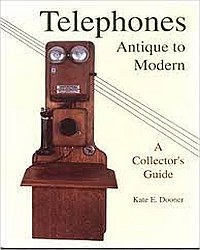 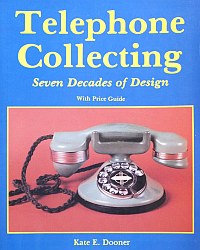 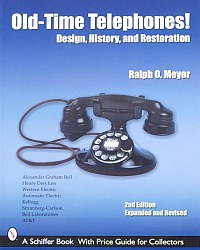 [B] [C] [D]
FROM INVENTION OF THE "TELEFON" IN GERMANY ...
-----------------------------------------------
[B] [C] [D]
FROM INVENTION OF THE "TELEFON" IN GERMANY ...
-----------------------------------------------
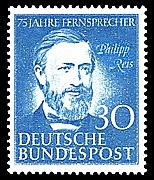 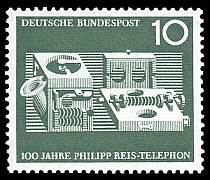 See WIKIPEDIA ...
https://de.wikipedia.org/wiki/Philipp_Reis
https://en.wikipedia.org/wiki/Johann_Philipp_Reis
https://en.wikipedia.org/wiki/Reis_telephone ... and more !!!
The DEUTSCHE BUNDESPOST made a POSTAL STAMP in 1952 - celebrating J.P.REIS -
"75 Jahre Telefon in Deutschland" and, in 1961, a POSTAL STAMP commemorating
the centenary of J.P.REIS's success of constructing in 1861 a working device
he christened "TELEPHON". ======
JOHANN PHILIPP REIS (1834 - 1874) was born in Gelnhausen near Kassel / Germany.
The story of his LIFE & DETAILS about his INVENTION, can be found in WIKIPEDIA
( see LINKs above !).
... TO ITS COMMERCIAL SUCCESS MADE IN THE USA:
-----------------------------------------------
Alexander Graham Bell (1847-1922) is associated with the invention of American
telephones. Born in Edinburgh, Schottland, he was inspired in this field by
assisting his father Melville's invention of "Visible Speech": A method to help
people with phonetics of foreign languages. The method proved useful too in
training the deaf. (The "Visible Speech" inspired G.B.Shaw's play » Pygmalion «
- and in the musical version, » My Fair Lady «, Prof. Higgins represents Prof.
Melville Bell.) In 1864, at the age of 17, Alexander was a master teacher. His
research in speech and sound led him to the invention of a "Harmonic Telegraph"
- a method to transmit different messages in parallel through ONE telegraph-line.
After the death of his two brothers of tuberculosis, the father moved the family
to a more pleasant climate in Brantford, Canada. In 1872 he opened his own school
for the deaf in Boston, Massachusetts and taught vocal physiology at Boston Univ.
With the financial help from the parents of his students (one of which, Mabel, he
married), 1875 he expanded his research and hired Thomas A.Watson to help him with
his mechanical work. Bell became aware of a competitor who, at the same time, was
experimenting with a "Harmonic Telegraph" ...
Elisha Gray, related to Western Union Telegraph Co., had constructed a telegraph
with eight metal reeds which could vibrate in correspondence to the eight notes of
the diatonic scale. He got a patent in 1875 stating that, if multible tones could
be sent over the same wire, so the human voice too. Both Bell and Gray worked on
the improvement of their transmitters and both filed their patents on Valentine's
Day, Feb. 14, 1876, but Bell was some hours earlier. March 10, 1876 the historical
words from Bell "Mr.Watson, come here I want you!" were transmitted over a
wire to another part of the house. On the Centennial Exposition in Philadelphia in
1876, Bell and Gray showed their models and made the public aware of their new dis-
covery. But there was a lot more to do to make the telephone a commercial success.
Western Union hired Thomas A.Edison and the Bell Company found Emile Berliner (a
German immigrant) to further improve the invention. The Western Union refused an
offer to buy the rights from Bell in hope they win the race anyway. After patent
struggles and settlements, both groups "set out on a different course to reap the
financial benefits of their research" ...
... SEE A WALL PHONE FROM 1900 + HOW IT WORKS ...
... AND FOLLOW THE TELEPHONE EVOLUTION OF LATER YEARS ...
BELL TELEPHONE COMPANY
----------------------
was founded 1877 in Boston, Massachusetts. In 1879 WESTERN UNION gave up all its
patent claims against the Bell company and the BELL TELEPHONE CO. got the legal
monopoly of the telephone business until 1894 when Bell's patents expired. In 1881
the Bell company bought WESTERN ELECTRIC, the telephon branch of Western Union. In
1885 a subsidary of the Bell Telephone Co. was formed to build and operate long
distance lines under the name AMERICAN TELEPHONE & TELEGRAPH (AT&T). Research
was done in the BELL LABORATORIES. The transistor was discovered there and John
Bardeen, Walter Brattain and William Shockley got the Nobel Prize for in 1956.
The transistorized "Touch Tone Telephone" was introduced in 1963. To establish
a telephone-connection it uses "Tones" instead of "Pulses".
WESTERN ELECTRIC COMPANY
------------------------
was founded in 1877 by Elisha Gray and Enos M. Barton in Cleveland, Ohio - later,
moved to Chicago, Illinois - to produce telegraph and telephone equipment for the
Western Union. In 1881 the Bell Company bought WESTERN ELECTRIC and W.E. became
the sole supplier of equipment for Bell Systems.
AUTOMATIC ELECTRIC COMPANY
--------------------------
begins with an ANECDOTE [ B ]:
" ... In 1891 Almond B. Strowger, a Kansas City undertaker, felt deceived because
his competitor's wife worked the local switchboard. He feared she was deliberately
directing his calls to his competition, so he determined to develop a telephone
system which would eliminate the go-between switch-board operator. In doing so, he
developed the first automatic dial system ... "
Strowger joined with Joseph Harris and founded the » Strowger Automatic Telephone
Exchange Co.« In 1901 they merged into AUTOMATIC ELECTRIC CO., Chicago, Illinois.
In 1955 the company was purchased by GENERAL TELEPHONE & ELECTRONICS (GTE).
HAVE A LOOK HOW A DIAL SYSTEM WORKS ...
GRAY TELEPHONE AND PAY STATION COMPANY
--------------------------------------
begins also with an ANECDOTE [ B ]:
" ... In 1888, twelve years after the invention of the first telephone, William
Gray, a machinist in Hartford, Connecticut, was in dire need of making a telephone
call. His wife was critically ill and he desperately needed to call a doctor.
When he was denied access to the factory phone, he determined to develop a pay
phone for the general public ... "
William Gray received a patent on Aug.13, 1889 for a coin operated device to
work the telephone. Later in 1905 Gray developed a pay station with coin identi-
fication that the operator could hear: Coins inserted in slots fell upon gongs
and bells and the distinct sounds were transmitted with Elisha Gray's "Harmonic
Telegraph" device. If (e.g.) a "QUARTER"-Coin (= 25 Cent) was dropped into a
"Silver-Dollar"-Slot, "NO RESONANCE" was recognized by the operator. Therefore
every pay station had the instruction:
+-----------------------------------------------------+
| DO NOT DEPOSIT COINS UNTIL OPERATOR ASKS FOR IT |
+-----------------------------------------------------+
Gray founded GRAY TELEPHONE AND PAY STATION CO.in Hartford, Connecticut which
held a monopoly on the pay station well into the 20th century. In 1948 the
company was aquired by the Automatic Electric Co.
HAVE A LOOK INSIDE A FANCY »AE« DIAL PAY PHONE ...
ENJOY A TOUR THROUGH THE TELEPHONE COLLECTION ...
R E M A R K :
===================================================================================
!! DIAL-PHONES & KEY-PAD-PHONES may no longer work on MODERN (eg. "VOIP"- ) NETS !!
[ A ]
There are "PULSE-TO-TONE-CONVERTER" on the market for this: I found the "DIALGIZMO"
(~ 50 US$ ) useful - There is a way to sent also the "KEY-COMMANDS" [*] & [#] for
automatic menue-guided systems ...
[ B ]
There is a "XLINK"-Interface (~ 90 US$ ) to Androids/iPhones on the market ...
SEE DETAILS in the "FAQs"-Chapter ...
POST-SCRIPT:
The EVOLUTION of CALCULATORS ...
... from the "Full-Keyboard" (1925) to the "10-Figure-Block" (1970) ... See WIKIPEDIA ...
https://de.wikipedia.org/wiki/Philipp_Reis
https://en.wikipedia.org/wiki/Johann_Philipp_Reis
https://en.wikipedia.org/wiki/Reis_telephone ... and more !!!
The DEUTSCHE BUNDESPOST made a POSTAL STAMP in 1952 - celebrating J.P.REIS -
"75 Jahre Telefon in Deutschland" and, in 1961, a POSTAL STAMP commemorating
the centenary of J.P.REIS's success of constructing in 1861 a working device
he christened "TELEPHON". ======
JOHANN PHILIPP REIS (1834 - 1874) was born in Gelnhausen near Kassel / Germany.
The story of his LIFE & DETAILS about his INVENTION, can be found in WIKIPEDIA
( see LINKs above !).
... TO ITS COMMERCIAL SUCCESS MADE IN THE USA:
-----------------------------------------------
Alexander Graham Bell (1847-1922) is associated with the invention of American
telephones. Born in Edinburgh, Schottland, he was inspired in this field by
assisting his father Melville's invention of "Visible Speech": A method to help
people with phonetics of foreign languages. The method proved useful too in
training the deaf. (The "Visible Speech" inspired G.B.Shaw's play » Pygmalion «
- and in the musical version, » My Fair Lady «, Prof. Higgins represents Prof.
Melville Bell.) In 1864, at the age of 17, Alexander was a master teacher. His
research in speech and sound led him to the invention of a "Harmonic Telegraph"
- a method to transmit different messages in parallel through ONE telegraph-line.
After the death of his two brothers of tuberculosis, the father moved the family
to a more pleasant climate in Brantford, Canada. In 1872 he opened his own school
for the deaf in Boston, Massachusetts and taught vocal physiology at Boston Univ.
With the financial help from the parents of his students (one of which, Mabel, he
married), 1875 he expanded his research and hired Thomas A.Watson to help him with
his mechanical work. Bell became aware of a competitor who, at the same time, was
experimenting with a "Harmonic Telegraph" ...
Elisha Gray, related to Western Union Telegraph Co., had constructed a telegraph
with eight metal reeds which could vibrate in correspondence to the eight notes of
the diatonic scale. He got a patent in 1875 stating that, if multible tones could
be sent over the same wire, so the human voice too. Both Bell and Gray worked on
the improvement of their transmitters and both filed their patents on Valentine's
Day, Feb. 14, 1876, but Bell was some hours earlier. March 10, 1876 the historical
words from Bell "Mr.Watson, come here I want you!" were transmitted over a
wire to another part of the house. On the Centennial Exposition in Philadelphia in
1876, Bell and Gray showed their models and made the public aware of their new dis-
covery. But there was a lot more to do to make the telephone a commercial success.
Western Union hired Thomas A.Edison and the Bell Company found Emile Berliner (a
German immigrant) to further improve the invention. The Western Union refused an
offer to buy the rights from Bell in hope they win the race anyway. After patent
struggles and settlements, both groups "set out on a different course to reap the
financial benefits of their research" ...
... SEE A WALL PHONE FROM 1900 + HOW IT WORKS ...
... AND FOLLOW THE TELEPHONE EVOLUTION OF LATER YEARS ...
BELL TELEPHONE COMPANY
----------------------
was founded 1877 in Boston, Massachusetts. In 1879 WESTERN UNION gave up all its
patent claims against the Bell company and the BELL TELEPHONE CO. got the legal
monopoly of the telephone business until 1894 when Bell's patents expired. In 1881
the Bell company bought WESTERN ELECTRIC, the telephon branch of Western Union. In
1885 a subsidary of the Bell Telephone Co. was formed to build and operate long
distance lines under the name AMERICAN TELEPHONE & TELEGRAPH (AT&T). Research
was done in the BELL LABORATORIES. The transistor was discovered there and John
Bardeen, Walter Brattain and William Shockley got the Nobel Prize for in 1956.
The transistorized "Touch Tone Telephone" was introduced in 1963. To establish
a telephone-connection it uses "Tones" instead of "Pulses".
WESTERN ELECTRIC COMPANY
------------------------
was founded in 1877 by Elisha Gray and Enos M. Barton in Cleveland, Ohio - later,
moved to Chicago, Illinois - to produce telegraph and telephone equipment for the
Western Union. In 1881 the Bell Company bought WESTERN ELECTRIC and W.E. became
the sole supplier of equipment for Bell Systems.
AUTOMATIC ELECTRIC COMPANY
--------------------------
begins with an ANECDOTE [ B ]:
" ... In 1891 Almond B. Strowger, a Kansas City undertaker, felt deceived because
his competitor's wife worked the local switchboard. He feared she was deliberately
directing his calls to his competition, so he determined to develop a telephone
system which would eliminate the go-between switch-board operator. In doing so, he
developed the first automatic dial system ... "
Strowger joined with Joseph Harris and founded the » Strowger Automatic Telephone
Exchange Co.« In 1901 they merged into AUTOMATIC ELECTRIC CO., Chicago, Illinois.
In 1955 the company was purchased by GENERAL TELEPHONE & ELECTRONICS (GTE).
HAVE A LOOK HOW A DIAL SYSTEM WORKS ...
GRAY TELEPHONE AND PAY STATION COMPANY
--------------------------------------
begins also with an ANECDOTE [ B ]:
" ... In 1888, twelve years after the invention of the first telephone, William
Gray, a machinist in Hartford, Connecticut, was in dire need of making a telephone
call. His wife was critically ill and he desperately needed to call a doctor.
When he was denied access to the factory phone, he determined to develop a pay
phone for the general public ... "
William Gray received a patent on Aug.13, 1889 for a coin operated device to
work the telephone. Later in 1905 Gray developed a pay station with coin identi-
fication that the operator could hear: Coins inserted in slots fell upon gongs
and bells and the distinct sounds were transmitted with Elisha Gray's "Harmonic
Telegraph" device. If (e.g.) a "QUARTER"-Coin (= 25 Cent) was dropped into a
"Silver-Dollar"-Slot, "NO RESONANCE" was recognized by the operator. Therefore
every pay station had the instruction:
+-----------------------------------------------------+
| DO NOT DEPOSIT COINS UNTIL OPERATOR ASKS FOR IT |
+-----------------------------------------------------+
Gray founded GRAY TELEPHONE AND PAY STATION CO.in Hartford, Connecticut which
held a monopoly on the pay station well into the 20th century. In 1948 the
company was aquired by the Automatic Electric Co.
HAVE A LOOK INSIDE A FANCY »AE« DIAL PAY PHONE ...
ENJOY A TOUR THROUGH THE TELEPHONE COLLECTION ...
R E M A R K :
===================================================================================
!! DIAL-PHONES & KEY-PAD-PHONES may no longer work on MODERN (eg. "VOIP"- ) NETS !!
[ A ]
There are "PULSE-TO-TONE-CONVERTER" on the market for this: I found the "DIALGIZMO"
(~ 50 US$ ) useful - There is a way to sent also the "KEY-COMMANDS" [*] & [#] for
automatic menue-guided systems ...
[ B ]
There is a "XLINK"-Interface (~ 90 US$ ) to Androids/iPhones on the market ...
SEE DETAILS in the "FAQs"-Chapter ...
POST-SCRIPT:
The EVOLUTION of CALCULATORS ...
... from the "Full-Keyboard" (1925) to the "10-Figure-Block" (1970) ...
 ==> ==>  <<<< Click on Pics !!
... Key [9] is "on top" ... and so it was taken to all COMPUTER Keyboards
=====================================================================================
?? and why are TELEPHONE KeyPads different to the COMPUTER 10-Figure-Blocks ??
===================================================================================== <<<< Click on Pics !!
... Key [9] is "on top" ... and so it was taken to all COMPUTER Keyboards
=====================================================================================
?? and why are TELEPHONE KeyPads different to the COMPUTER 10-Figure-Blocks ??
=====================================================================================
 (WE 1965)
BELL-LABS invented "Tone-Dial" to speed up dial-time. In 1950s BELL-LABS designed
its KeyPad and made TESTs: It was found, that numbers ascending from top to bottom
was for most customers "more intuitive" ... and so the "TELEPHONE-Standard" was set.
impressum:
*************************************************************************************
© C.HAMANN http://public.BHT-Berlin.de/hamann 09/03/25 (WE 1965)
BELL-LABS invented "Tone-Dial" to speed up dial-time. In 1950s BELL-LABS designed
its KeyPad and made TESTs: It was found, that numbers ascending from top to bottom
was for most customers "more intuitive" ... and so the "TELEPHONE-Standard" was set.
impressum:
*************************************************************************************
© C.HAMANN http://public.BHT-Berlin.de/hamann 09/03/25
|
REMARKS TO THE INVENTION OF THE TELEPHONE
======================================================= ... based on the books ...
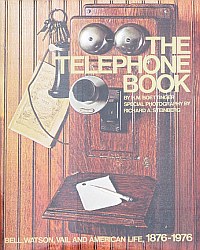
REMARKS TO THE INVENTION OF THE TELEPHONE
======================================================= ... based on the books ...
